Text and photos: Akul Tripathi
Two Dominions are born”, read the headline of The Statesman dated Friday, 15 August 1947, “Political Freedom for one-fifth of the human race”. Several other sub-headings emphasised other important events amongst the thousands of things that were happening for the first time. “Power Assumed by Indians”, “Constituent Assembly Members take the Oath” and “Work for Common Prosperity”.
“India Independent: British Rule Ends”, declared the Hindustan Times. “India and Pakistan Become Nations; Clashes Continue”, the New York Times headlined on its front-page, across two columns. “Climax at midnight”, read a sub-heading.
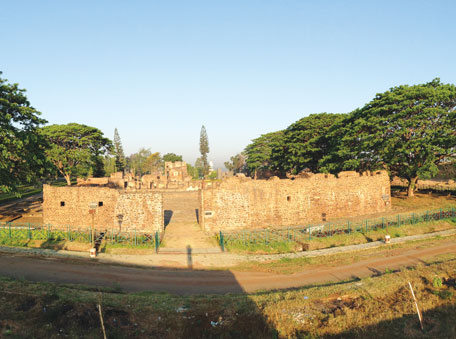
In a manner of speaking, the freedom struggle which climaxed on that glorious midnight was, in retrospect, quite like the way the World Cup Cricket hosted by the sub-continent nations is organised. Spread over the subcontinent without regard to international borders. The way various cities and stadiums hold various matches that end in a final in the Wankhede in Mumbai or Eden Garden in Kolkata; the freedom struggle spanned challenges that were overcome in places that we perhaps no longer remember, places that perhaps no longer exist – places on the shoulders of which climbed Nehru to keep his ‘tryst with destiny”.
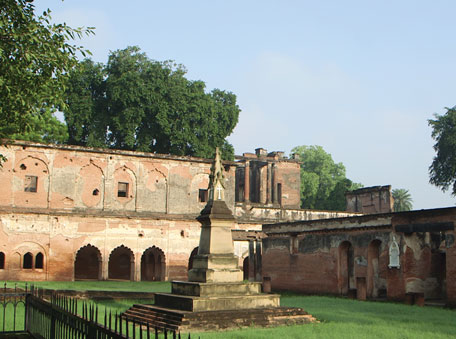
It would take many volumes to identify and trace an entire list of all the agitations, protests, revolutions and satyagrahas in this vast expanse of ancient land that it took for the British to finally realise that they were never wanted, and as much as we deify our guests, they had taken one too many liberties on that virtue. However, here is a collection, a small sample of various events, varied in nature time and place, but perhaps symbolic of the gargantuan task of mammoth scale and epic consequences that saw the sun set on an empire, ushered in a new era in history and may in a few centuries from now be read as a tale so fantastic and unbelievable, that future generations may well put it at par with the Ramayana and the Mahabharata.
Kittur
An unassuming place in Belgaum, Karnataka, whose name tragically does not evoke the sense of pride on a national level as is its right through valour that predates what we call the era of our freedom struggle. Much before Rani Laxmibai charged against the British in what has become the representation of heroism against British tyranny, Rani Chennamma of Kittur in 1829, protesting against the very same Doctrine of Lapse that allowed British interference in the way Indians ruled themselves, fought a war that stunned the British. After winning the first battle and even taking in prisoners of war, it was British deceit and treachery engineered by an East India Company trying to save face and its foothold in a country where they may just be ousted by a woman, that led to a defeat for the brave Rani. Nonetheless, it did not go unnoticed and while others may have not rallied around her then; that even the British could crack was a seed that was sowed right here. A fort, a small museum and a memorial is what remains of the unbowing Rani’s legacy. While national history may place her as a footnote, if that, the heroics of Kittur Rani Chennamma are sung by folks in the form of ballads, lavani and GiGi pada.
Lucknow Residency
With a target of consolidating their hold on India, the East India Company set up a post of a Resident. Much like present day embassies and ambassadors, the office of the British Resident was a political office which originated after the Battle of Plassey. The Resident was a senior British official, technically a diplomat, whose job was to ensure that the alliances and treaties built with local Indian rulers were fulfilled. The Lucknow Residency is a complex of buildings in a common precinct. It served as the office of the British Resident in the Oudh Court of the Nawabs of Lucknow.
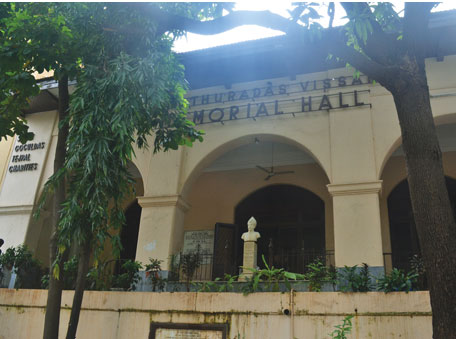
Quite organically, this magnificent building, built at the expense of the Nawab became the symbol of the British resolve to stay in India during the First War of Independence, when the complex came under seige. The uprising began at Meerut and then gradually spread towards Lucknow. Noticing the turmoil and worsening conditions, all Europeans in and around Lucknow had sought refuge in the residency. Revolutionaries poured in from all sides and soon, the premises were surrounded. The siege of the Lucknow Residence began in earnest on 1 July 1857. Several efforts were being made to evacuate the hostages.
Once the revolution was contained across the country, the Company put their entire might behind getting the trapped Britishers from the Residency. A large relief force marched to Lucknow and after much fighting reached the Residency. The evacuation began on 19 November and lasted till 24 November. The siege had lasted 148 days. The Indian forces held Lucknow till it was recaptured by the British on 21 March 1858.
Being the first revolt on such a large scale against the British, the First War of Independence was quite a jolt to the British and a reminder of their slippery toe-hold in India. The siege and the subsequent successful evacuation have garnered various representations in popular culture. Various books are inspired or based or carry significant accounts of the Siege of Lucknow. This includes works by Mark Twain, Maxwell Gray and Philip Pullman. Alfred Tennyson’s “The Defence of Lucknow”, is a poem depicting the events leading up to the day of the first attempt to evacuate the people trapped.
Gokuldas Tejpal College of Sanskrit
On 28 December 1885, a group of 72 Indian lawyers, academics and journalists gathered at Gokuldas Tejpal Sanskrit College in Mumbai to form the Indian National Congress (INC) with W.C. Bannerjee as Chairman, and Allan Octavian Hume assuming office as the General Secretary. Other delegates included the likes of Dadabhai Naoroji, Justice Ranade, Pherozeshah Mehta, K.T. Telang and Dinshaw Wacha.
That a small school became this place which formed the organisation that became the torchbearer for India’s independence, was as inadvertent as the consequences of the formation of this party by the pen and the mind of the British, would have for them.
After the war of 1857, the British Crown took up the administration of the Indian colony in its own hands relieving the East India Company of this burden. They set up imperial headquarters in Kolkata. A theory states that as a policy, the British went about trying to have dialogue and pacify the ‘natives’ to avoid or at least be pre-warned of any other uprising like the one that caused the Company to lose this profitable colony. Proponents of this theory believe that Hume, a civil servant of British India became the person to put in place the safety valve of being the single point of contact for the various concerns locals might have for the colonial government.
The idea of the Congress took concrete shape during a meeting of the Theosophical Convention in Madras in December 1884. In March 1885 a notice was issued convening a meeting at Pune in December of the same year, but due to a severe plague outbreak there, the meeting was later shifted to Bombay. The venue – the Gokuldas Tejpal College of Sanskrit. This theory of the Congress as the “safety valve” enjoyed great popularity for decades till some painstaking research questioned the merits of this theory and made many converts. Many in the British ranks, it turns out, thoroughly disapproved of Hume’s dabbling with Indian nationalists and anyway, something like a Congress was already in the making through the independent initiative of Surendranath Bannerjee and others.
Walking in his footsteps
Porbander
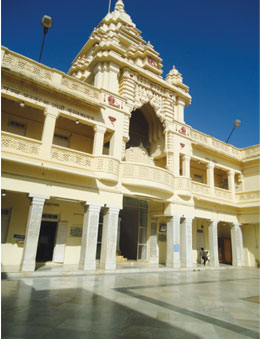
Sabarmati Ashram
On the banks of the River Sabarmati, at a little distance from Ahmedabad is located the Sabarmati Ashram, which was for about 12 years the home of Mahatma Gandhi and his wife. It is believed that this is one of the ancient ashram sites of Dadhichi Rishi, who had donated his bones for a righteous war. The ashram is sited between a jail and a crematorium, and Gandhi believed that a satyagrahi has invariably to go to either place. The ashram today is a museum that houses several of Gandhi’s belongings.
Sevagram
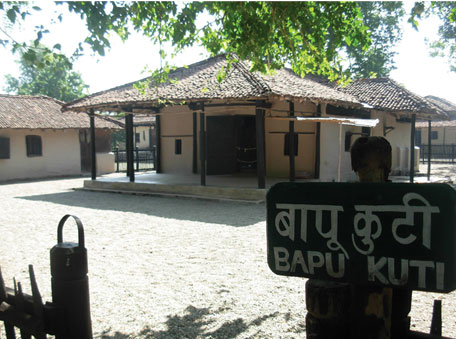
Mani Bhavan
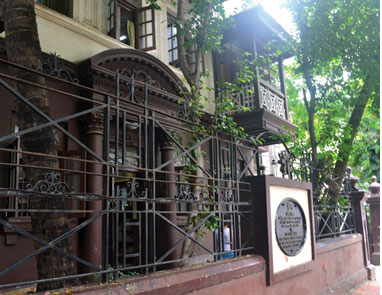
Birla House, now called Gandhi Smriti
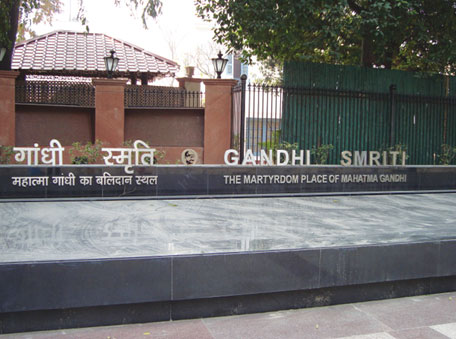
That there would soon be a more organised form of protest against the British government is beyond doubt. That the institution formed by a British national brought about its demise adds wry humour to the entire tale. Wry humour for us and a wincing grimace for the British.
Cellular Jail – the dreaded Kaala Paani
The context of the creation of an incarceration facility in the Andaman Islands stemmed from the First War of Independence in 1857. After India’s First War of Independence, the British thought it imperative to have a penal colony away from the mainland for the ‘hardcore’ elements.
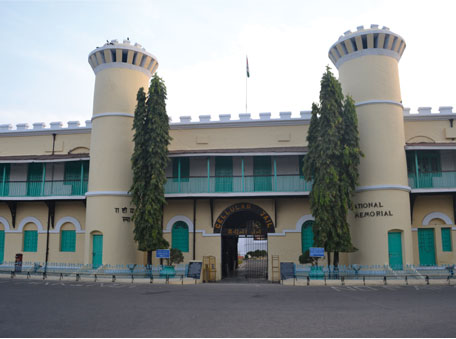
As per Hindu customs, crossing the sea would make one an outcast. This saagarolanghan or samudraolanghan wipes away the varna status and crossing the sea would make the sepoys, who were mostly Brahmins and Kshatriyas, to lose their caste, so precious to every Indian and the very thought of it would serve as a crippling psychological fear.
After makeshift open jails at Ross Island and Viper Island, the British decided it was necessary to build a more severe penal facility for the offenders sentenced to Kaala Paani which could hold them in solitary confinement. The Cellular Jail started being constructed at Port Blair in 1896 and was finished in 1906. It is a three-storey structure shaped like a large starfish. Seven wings radiate from a central watch tower and 698 people could be kept in solitary confinement. Each cell was just 13.5×7.5 feet wide and at a height of 3m was the sole ventilator in the cell. The central tower had a large bell to raise an alarm in case of any eventuality. The cells were designed such that the face of a cell in a wing saw the back of cells in another wing making communication impossible. Due to these cells of solitary confinement, the incarceration facility got its name – Cellular Jail. Accounts and tales of people incarcerated in this dreadful cauldron of human suffering would break the strongest heart. Bankim Chakraborty called Indian jails a Begum’s paradise compared to Andamans.
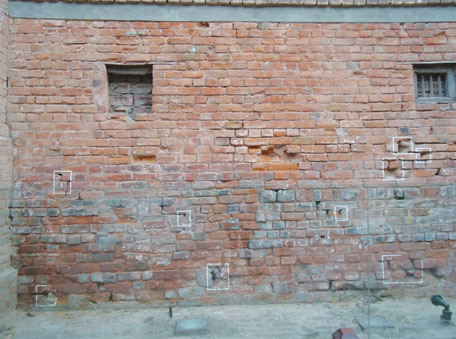
The atrocities at this inhuman facility continued till the 1930s when massive hunger strikes began calling attention to their suffering. The news of their plight spread like wildfire through Bengal and the country got behind the prisoners. A telegram arrived from Gandhiji – “Nation-wide request to abandon the strike… trying best to secure relief for you. MK Gandhi”. In September 1937, following the protests, the first group of prisoners was repatriated. The Cellular Jails were forced to empty in 1939 and two years later, the Japanese seized the islands, transforming them into a prisoner of war camp where, in a perhaps deserving twist of fate, the warders became the prisoners.
Champaran
Mahatma Gandhi’s first major achievement in India came in the form of the Champaran satyagraha in 1918. Champaran is today two districts in the state of Bihar. The plight of the farmers of Champaran was their British landlords, who, backed by the local administration compelled the farmers to grow the cash crop indigo and were forced to sell the produce for a fixed price. With no other recourse in sight, they approached Gandhi at his Ahmedabad ashram and appealed to him to intervene and help. In the first display in India of his strategy of non-violent protest, Gandhi caught the administration unawares and won several concessions for the farmers.
Jallianwala Bagh
There is scarcely a soul alive in this country who would not know of the Jallianwala Bagh massacre – the day the British government resorted to terrorism. On 13 April 1919, which also happened to be Baisakhi, a senior British officer, General Reginald Dyer, opened fire on a gathering of unarmed men, women and children protesting British rule at Jallianwala Bagh in Amritsar, Punjab. Positioning his men at the sole narrow gateway, Dyer ordered his 50 British-Indian troops to open fire. The firing continued for 10-15 minutes, during which time, according to official sources, 400 civilians were killed and 1200 wounded. Unofficial records put the toll much higher.
An inquiry committee set to investigate the massacre was faced by a remorseless Dyer. The ‘Butcher of Amritsar’, Dyer was removed from command but did not face any penal or disciplinary action because of politico-legal limitations and several senior officials condoning his actions. To avenge the Jallianwala Bagh massacre, revolutionary Udham Singh killed Sir Michael Francis O’Dwyer, who was Lieutenant Governor of Punjab at that time, in London in 1940. O’Dwyer had called the massacre a “correct action”.
The massacre has since been characterised as the turning point in the history of British India, the event that lost Britain her ‘jewel in the crown’. It is compared to the Boston Tea Party after which the Anglo-Indian relations never remained the same. It is in retrospect seen as the singular event that made the rift between the ruler and the ruled a chasm.
Moirang
In a far-flung remote corner of the north-east Indian state of Manipur, is the city of Moirang, which is today its largest tourist town. During World War II, Moirang was the headquarters of the Azad Hind Fauz, also known as the Indian National Army (INA). The INA was first founded in 1942 and was later revived by Bose in 1943. Following the hoisting of the flag, Moirang became the headquarters of the INA and occupies a place in the historical annals of India’s freedom movement. The INA memorial also houses a museum which contains some mementos and personal artifacts of people involved with the INA. Netaji Subhash Chandra Bose hoisted the Indian flag at this spot for the very first time on 14 April 1944.
August Kranti Maidan
In Grant Road in Mumbai is the Gowalia Tank Maidan that was once a water tank. Coming from the Marathi words Go (cow) and walia (owner of), it was a water body where cows would be bathed. It was once a prime tram terminus too. The park that now exists over there was built on this tank.
On 8 August 1942, Gandhi launched the Quit India movement from this maidan. He gave the call to ‘Do or Die’ to the Indian masses to stage a massive Civil Disobedience movement as the British refused to grant independence till the Second World War was over. While the movement is seen as a failure due to heavy suppression and lack of unity across various fragments of the political leadership with many quarters such as the Muslim League, the Hindu Mahasabha, Communist Party of India, various princely states and the Rashtriya Swayamsevak Sangh opposing or boycotting Gandhiji’s call.
Within hours of the announcement, all of the senior Congress leadership was arrested and kept locked up for three years till the end of war, with no contact with the outside world or the people of India. However, the British government realised that India was ungovernable in the long run, and the question for postwar became how to exit gracefully and peacefully.
Aga Khan Palace
The Aga Khan Palace of Pune, built in 1892 by Imam Sultan Muhammad Shah Agakhan III has become a national monument which enshrines a time of India’s freedom movement. Following the launch of Quit India movement in 1942, Gandhiji, his wife Kasturba 
Ahmednagar Fort
The Ahmednagar Fort, located in Ahmednagar district in Maharashtra, was the capital of the Ahmednagar Sultanate. Malik Shah Ahmed, who lent his name to the city, built the fort in 1427 CE.
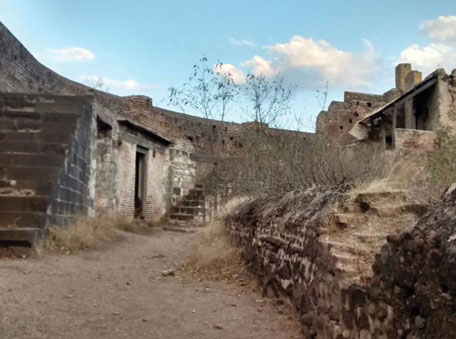
The fort continued to be in use during the time of the British colonialists. It was used as a prison and many stalwarts of Indian independence struggle like Pandit Jawaharlal Nehru, Abul Kalam Azad, and Sardar Patel were imprisoned there. Nehru wrote his magnum opus, Discovery of India, while interned at the fort.
Gateway of India
To commemorate the landing of British King George V and Queen Mary at Apollo Bunder, the Governor of Bombay, Sir George Sydenham Clarke laid its foundation on 31 March 1911. The construction of this iconic landmark was completed in 1924.
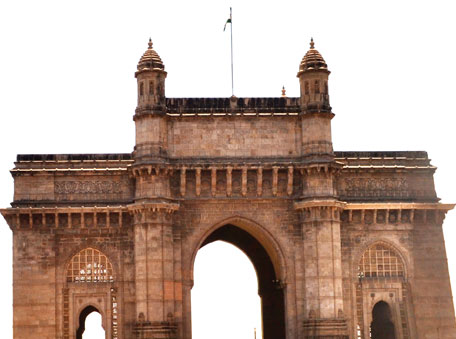
First Light
“Uphill Task Ahead” was the banner of the advertisement by the United Commercial Bank, Calcutta, on the back page of the 15 August 1947 edition of The Statesman. “Free India’s first and foremost task is to raise our economic stature by waging a relentless war on poverty,” it continued. “Ours is a country exceptionally rich in natural resources …Let us, therefore, resolve on this Freedom Day to attack the parasite of need through education, organisation, increased economic tempo and personal hard work.” The advertisement went on to compare annual per capita incomes of India (Rs. 65), the UK (Rs.980) and the USA (Rs.1,406) in 1947. Sixty-eight years from the day, the World Bank statistics pegged growth in 2014 at 2.4% and 2.6% for US and the UK, with India emerging the world’s fastest growing economy at 7.4%.
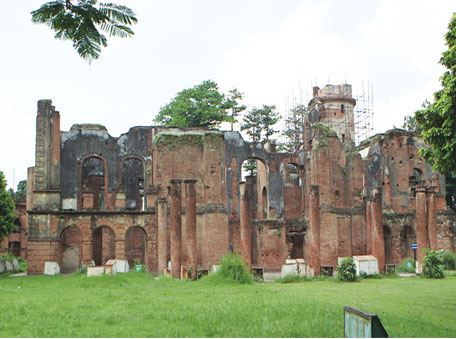
It is said that the British flag over the Residency was never lowered, even at sunset. The display of the flag had become that necessary for the British psyche. At sunset on 13 August 1947, the Union Jack which had fluttered since 1857 night and day, atop the Residency in Lucknow, was brought down by the caretaker, Warrant Officer Ireland. A small party of British officers led by Major General Curtis watched the flag come down and the sun setting on the British Raj in India. That night the British Sappers cut the steel flag staff of the Residency from the base and pulled out its foundation. Then they re-cemented the place, leaving no trace whatsoever of the flag pole on which for 190 years the symbol of British power had flown high without a break. The Union Jack which was removed from the Residency was sent to Field Marshal Auchinleck who sent it to George VI in England. This flag and another British flag which was brought down from the ramparts of Fort William in Calcutta were consigned to the museum in Windsor Castle.
Like the Manchester Guardian opined on the day of India’s independence, there were beds of roses and there were patches of thorns. The two hid under each other at times shocking and surprising us while we wondered whether these were presents and penalties our founding fathers were aware of. Floundering and faltering, we are with each passing day, writing a story in the annals of time. Our story. A story that builds a case, with each year that we add to independent democratic secular rule. A case that puts history in perspective and argues in a voice that has come from a quivering whisper to a confident assertion that not everything in history need repeat itself. That sometimes, to break away from it will create a history that, were it to repeat as history tends to, will aid in the formation of a world more at ease with itself. At peace with itself.
The year 2015 marks the centenary of a very special event. A hundred years ago, in January 2015, an already middle aged Gandhi (46 years) arrived in India, alighting from the SS Arabia at Bombay Harbour, after transforming the political landscape of South Africa.
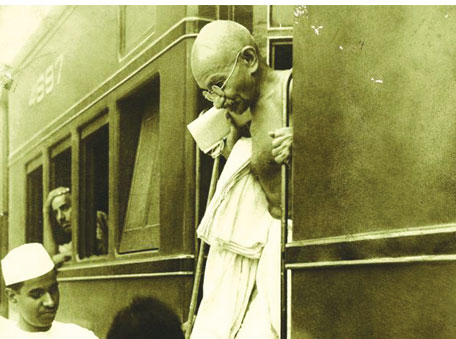
Though he was a devout Hindu and could be considered orthodox by today’s standards, he was extremely well travelled and his experiences were almost unusually heterodox for an Indian of his times. Gandhi had noticed that as much as the Indians drew boundaries and bickered amongst themselves at home, while abroad, where the hardships of a new life were equal to them, these divides seemed to blur and even disappear. This first hand observation and knowledge filled him with hope that his fellow countrymen could be persuaded to find a space beyond their differences and strive together to realise a shared goal.
On arriving, he promised his mentor, Gopal Krishna Gokhale, that he would not speak or write or participate in the politics of India for a year, until he had travelled across the country and met its people first hand and lived their problems with them. And he did so the way and within the means of every Indian. In trains and on foot, he mingled with the men and women of his country till every shard of whatever it is that the western world might have enveloped him in was rubbed bare and what emerged was the loin cloth clad figure we know so well – the leader, who emerged from and as his people.
Excerpt from the script of Gandhi (1982).
A report by journalist Walker regarding the satyagrahis at Dandi
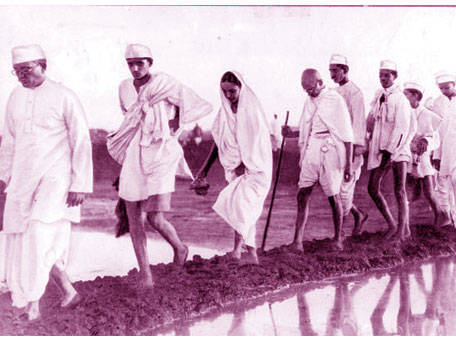
WALKER
“They walked, with heads up, without music, or cheering, or any hope of escape from injury or death.” (His voice is taut, harshly professional.) “It went on and on and on. Women carried the wounded bodies from the ditch until they dropped from exhaustion. But still it went on.”
He shifts the mangled notes and comes to his last paragraph. He speaks it trying only half successfully to keep the emotion from his voice.
WALKER
“Whatever moral ascendance the West held was lost today. India is free for she has taken all that steel and cruelty can give, and she has neither cringed nor retreated.”
(On Walker close. His sweating, blood and dirt-stained face near tears.)
“In the words of his followers, ‘Long live Mahatma Gandhi.’”
It was quite unfortunate that the architect of India’s magical freedom struggle was not present to view the last of the occupiers leave his country – the country he helped deliver from centuries of oppression. But I am pretty sure he was there in spirit – in the hearts of the several hundred who had gathered to watch the momentous occasion; in the thoughts of those leaving and their families and motherland who must have given silent thanks to him that so many of their sons were coming home; in the soul of the land and the seas that heaved in joy to be emancipated without being damp and running crimson with the blood of its own.
As he stays now, I hope. The spirit of the nation’s Father, breathing free in the land of his fathers. Yes, we truly are a part of an epic of our own making. Truly blessed, and now eternally unbound.


 [/column]
[/column]